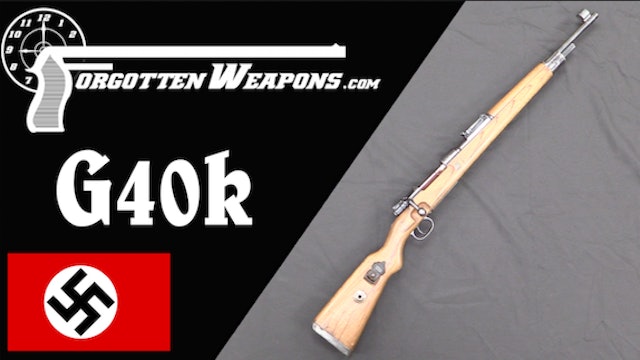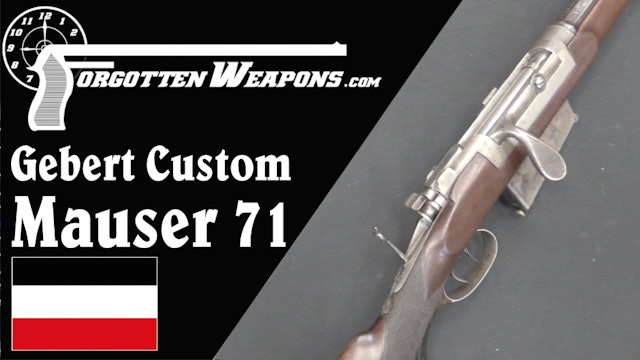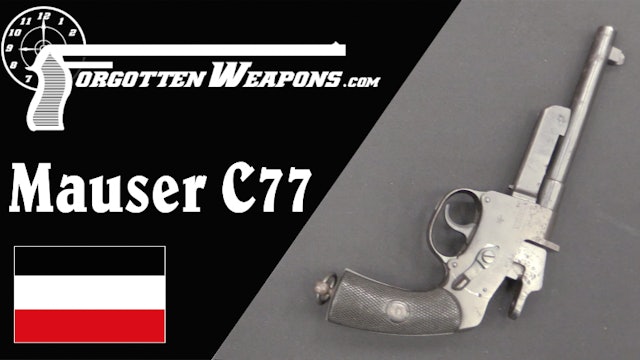-
German Sten Copy: MP 3008, aka Gerät Neumünster
The MP 3008, aka Gerät Neumünster, was one of two German efforts to copy the British Sten gun. The first was the Gerät Potsdam ("gerät" meaning device or project; basically project code name), which was a direct copy of the Sten distinguishable only by a marking details and a few differences in m...
-
Gewehr 98: The German WWI Standard Rifle
The Gewehr 1898 was the product of a decade of bolt action repeating rifle improvements by the Mauser company, and would be the standard German infantry rifle through both World Wars. Today we are looking at a pre-WWI example (1905 production) that shows all the features of what a German soldier ...
-
Development of the Luger Automatic Pistol
Lugers! there are approximately a gazillion different recognized varieties, because the pistol became so popular and iconic. And yet...they all kinda look the same, don't they? (If you are a Luger collector, don't answer that!) A great many ( I daresay the significant majority) of the Luger varia...
-
Ortgies Automatic Pistols: Not as Boring as You Think!
The Ortgies is a pistol whose interested aspects are often overlooked on the assumption that it is just another identical .32 ACP blowback pistol. Well, it is that - but it is also more.
Mechanically, the Ortgies has a rather unusual grip safety mechanism that is quite different from what we e...
-
Walther P38 Development
The Walther P38 was adopted by Germany in 1938 as a replacement for the P08 Luger - not really because the Luger was a bad pistol, but because it was an expensive pistol. Walther began development of its replacement in 1932 with two different development tracks - one was a scaled-up Model PP blow...
-
1929 Simson Prototype 9mm
In the late 1920s, German Ordnance hinted at an interest in replacing the P.08 Luger pistols with a less expensive handgun design. This prompted a number of submissions from hopeful companies, including this design from the Simson company of Suhl. It is chambered for the 9x19 Parabellum cartridge...
-
Mauser Selbstlader M1916 (Infantry Version)
The Mauser Selbstlader M1915 was the result of many years of work by the Mauser brothers to develop a semiautomatic rifle suitable for military use. They tried many different types of operating systems, and this one is a particularly unusual recoil-operated mechanism.
Only about 600 of these r...
-
Walther A115 Prototype
The Walther A115 was one of the semiauto rifles developed in pre-WWII Germany. Apparently only three were made, and it uses a neat combination of sheet metal construction with a rotating bolt and annular gas piston like the later G41 rifles. This particular example was examined by Aberdeen Provin...
-
Mauser Model 1878 "Zig-Zag" Revolver
After making their big break with the adoption of the Model 1871 Mauser rifle by the newly unified German government, the Mauser brothers, took a shot at getting the handgun contract for the military as well, with this revolver, the Model 1878. It is often colloquially called the Mauser Zig-Zag b...
-
The G40k: A German Experimental Mauser Carbine
In April 1940, WaPrüf 2 directed Mauser to begin development of a shortened Master carbine with a 490mm (19.3”) barrel, presumably for specialty troops. Development meandered on until July 1942, by which time just 28 rifles had been made, in two series. The first batch were numbered 3-15 and the ...
-
Sturmtruppen Firepower: The Artillery Luger
The lP08 (Lange pistole 08) was formally adopted in 1913 to replace the Reichsrevolver for the field artillery. These were the German light artillery troops, who were specifically given a pistol caliber carbine to provide maximum firepower in a very compact package. They were made by the Erfurt A...
-
Beautiful 1625 Breechloading Wheellock
Breechloading firearms did not become commonplace until the 1800s, but talented gunsmiths were experimenting with the concept and building custom breechloaders since virtually the very invention of firearms in the West. This is a magnificent example of an advanced German gun commissioned by a buy...
-
Gebert Custom Mauser 71 with all the Bells and Whistles
Made by Carl Gebert, a master gunsmith in Munich, this custom sporting rifle exhibits all the fancy options available in the 1870s or 1880s! The base action is an 1871 Mauser, which was a single shot rifle. However, this specially made one had been modified to us a fixed box magazine holding 3 or...
-
Heym SR30: Straight Pull Ball-Bearing Lock?
The Heym SR30 is a modern hunting rifle produced in Thuringia, Germany using a rather clever and interesting locking system. It is a straight-pull rifle with six ball bearings around the circumference of the bolt head. When the bolt handle it forward, it forces a central plunger down the interior...
-
Mauser 1877 Single-Shot Pistol
The Mauser brothers’ first attempt at a commercial or military handgun was this, the C77 (Construktion 1877) model of single shot pistol. Why a single-shot sidearm in 1877, well into the age of centerfire military revolvers? That is a good question. By the time the design was complete, the Mauser...
-
Walther WA2000: The Ultimate German Sniper Rifle
The Walther WA-2000 has a reputation of being the ultimate German sniper rifle, with no expense spared in its design and construction. Designed in the aftermath of the 1972 Munich Olympics massacre, the WA2000 was intended to be a police sniper rifle, not a military arm. It is a bullpup layout an...
-
Schwarzlose 1901 Toggle-Delayed Prototype
Andreas Schwarzlose was a German designer who created several very interesting and unusual handgun designs (in addition to his 1907 heavy machine gun, which was adopted as a standard arm of the Austro-Hungarian military). His first handgun was the model 1898, a short recoil, rotating bolt pistol ...
-
Could a Tankgewehr Really Take Out a British MkIV Tank?
The Tankgewehr antitank rifle was developed by the Mauser company and adopted by the Imperial German military as an emergency measure to counter the introduction of tanks to the WW1 battlefield. The question is, did they really work? Could a 13.2mm AP bullet from a Tankgewehr really perforate the...
-
Becker Blow-Forward Revolving Shotgun
The Becker shotgun is a very unusual blow-forward, revolving cylinder shotgun made in Germany in the 1920s (although it was originally patented in the late 1890s). Only a very small number were made - allegedly as few as 100. The serial number on this one appears to be 755, which could mean more ...
-
H&K Mk23 SOCOM .45 Development
The H&K Mk 23 pistol was developed in the 1990s for the US Special Operations Command and US Navy. The goal was to produce an "offensive handgun" that could serve as a primary armament for a special forces operator as well as a backup arm. It was required to be no more than 12 inches long, fit a ...
-
H&K's New SP5 - A Civilian Semiauto MP5 Pistol
The MP5 is widely regarded as the best submachine gun ever made, and it has been widely copied. But only now has H&K released a semiauto civilian version of it in pistol form. Prior to the AWB, the HK94 was available as a semiauto carbine (with a 16" barrel), but that was prohibited in 1988. H&K ...
-
HK-32 Prototype in 7.62x39mm
Among the large family of roller-delayed rifles produced by Heckler & Koch, one of the rarest and least known is the HK32. This was the select-fire shoulder rifle chambered in 7.62x39mm. These rifles appeared in H&K sales literature for a time, but were only made in very small numbers for one or ...
-
Papers Behind the Pistol: Mauser's Archives on the Model 1910
Courtesy of the Paul Mauser Archive, we have a very cool opportunity to look at the documentation and paperwork behind a production pistol design, from beginning to commercial sales. This sort of documentation is rare for pre-WW1 German small arms in general, and the Mauser Model 1910 pistol is a...
-
Evolution of the Military Mauser HSc Pistol
Mauser had been at the forefront of military self-loading pistol design with its C96 pistol, but by the 1930s it had lost major market share to Sauer and Walther in police and commercial guns. The Mauser 1910/1914/1934 line of compact pistols was getting a bit old, and the Sauer 38H and Walther P...

























